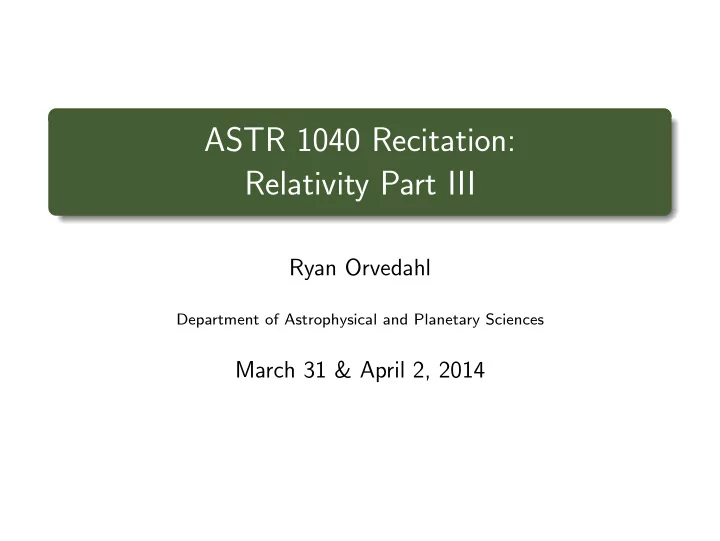

ASTR 1040 Recitation: Relativity Part III Ryan Orvedahl Department of Astrophysical and Planetary Sciences March 31 & April 2, 2014
This Week Night Observing: Wednesday April 2 (8:30 pm) Day Observing: Thursday Afternoon Use Heliostat and H α filters to view the Sun R. Orvedahl (CU Boulder) Mass Transfer Mar 31 & Apr 2 2 / 15
Today’s Schedule Past/Current Homework Questions? Past/Current Lecture Questions? More Special Relativity Group Projects R. Orvedahl (CU Boulder) Mass Transfer Mar 31 & Apr 2 3 / 15
Special Relativity Reminder Speed of light is constant for everyone Time Dilation Length Contraction R. Orvedahl (CU Boulder) Mass Transfer Mar 31 & Apr 2 4 / 15
Special Relativity: Time Dilation Train car moving to the right at speed v Person in train sends laser pulse from ground to a mirror directly above What does person on the ground see? R. Orvedahl (CU Boulder) Mass Transfer Mar 31 & Apr 2 5 / 15
SR Time Dilation Moving clocks run slow: t ′ = t √ 1 − ( v / c ) 2 R. Orvedahl (CU Boulder) Mass Transfer Mar 31 & Apr 2 6 / 15
Lorentz Transformations Traditional variables More compact form ct ′ = ct − ux / c √ ct ′ = γ ( ct − β x ) 1 − ( u / c ) 2 x ′ = γ ( x − β ct ) x ′ = x − ut √ 1 − ( u / c ) 2 y ′ = y y ′ = y z ′ = z z ′ = z β ≡ u / c & γ ≡ (1 − β 2 ) − 1 / 2 R. Orvedahl (CU Boulder) Mass Transfer Mar 31 & Apr 2 7 / 15
Group Project I: Velocities A Train moves with speed u with respect to the ground. What do people on the train measure for your a) x velocity, v ′ x b) y velocity, v ′ y ct ′ = γ ( ct − β x ) v x ≡ x / t x ′ = γ ( x − β ct ) v y ≡ y / t y ′ = y β ≡ u / c z ′ = z γ ≡ (1 − β 2 ) − 1 / 2 R. Orvedahl (CU Boulder) Mass Transfer Mar 31 & Apr 2 8 / 15
Group Project I: Answer � 2 � − 1 / 2 � u � γ ≡ 1 − c x = v x − u a) v ′ 1 − uv x c 2 v y b) v ′ y = γ (1 − uv x c 2 ) R. Orvedahl (CU Boulder) Mass Transfer Mar 31 & Apr 2 9 / 15
Group Project II: Introduction Distant galaxy emits radiation in ˆ y direction in S ′ frame (the rest frame of the source) What angle does the light make with the x axis in the S frame, which moves at speed u with respect to S ′ ? π/ 2, > π/ 2, < π/ 2? Why? R. Orvedahl (CU Boulder) Mass Transfer Mar 31 & Apr 2 10 / 15
Group Project II: Introduction Distant galaxy emits radiation in ˆ y direction in S ′ frame (the rest frame of the source) What angle does the light make with the x axis in the S frame, which moves at speed u with respect to S ′ ? π/ 2, > π/ 2, < π/ 2? Why? R. Orvedahl (CU Boulder) Mass Transfer Mar 31 & Apr 2 10 / 15
Group Project II: Doppler Beaming y direction in S ′ frame. What is sin θ in Galaxy emits light in ˆ S frame? θ is measured from x axis. v ′ x + u v x = x / c 2 1+ uv ′ v ′ v y = y x / c 2 ) γ (1+ uv ′ sin θ = v y / v v = � v 2 x + v 2 y R. Orvedahl (CU Boulder) Mass Transfer Mar 31 & Apr 2 11 / 15
Group Project II: Answer sin θ = 1 γ v ′ x + u v x = x / c 2 = u 1+ uv ′ v ′ � 1 − u 2 / c 2 v y = y x / c 2 ) = c γ (1+ uv ′ v = � v 2 x + v 2 y = c 1 − u 2 / c 2 = 1 /γ � ⇒ sin θ = v y / v = R. Orvedahl (CU Boulder) Mass Transfer Mar 31 & Apr 2 12 / 15
What About General Relativity? Special Relativity seems somewhat simple in the kind of math it uses What about General Relativity? It’s just messy R. Orvedahl (CU Boulder) Mass Transfer Mar 31 & Apr 2 13 / 15
Real General Relativity Einstein tensor (Curvature): G µν ≡ R µν − 1 2 Rg µν Include cosmological constant (Dark Energy): Λ Include matter/energy: T µν Full Einstein Equations: G µν + Λ g µν = 8 π G c 4 T µν R. Orvedahl (CU Boulder) Mass Transfer Mar 31 & Apr 2 14 / 15
Real General Relativity G µν + Λ g µν = 8 π G c 4 T µν is actually a set of 10 non-linear, partial differential equations, so very very hard to solve R. Orvedahl (CU Boulder) Mass Transfer Mar 31 & Apr 2 15 / 15
Recommend
More recommend